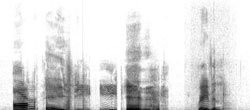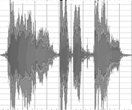Preparation
Voice messages will be cleaned of surrounding “noise” using various filters, and translated into a format compliant with a spectrograph analyzer (SpA)..
The SpA will process the sound file and display visual interpretations according to various parameters such as sample rate, frequency range, bands per octave, bandwidth filter, rows per second, etc. Slight adjustments to these parameters allow us to highlight certain aspects, increase output clarity, and choose the most suitable image from an artistic perspective.
At this stage, we have different types of black and white images, as illustrated in the examples below.

sample 1: 3D graphic
(sound level-frequency-time)
|

sample 2: 2D graphic
|

sample 3: 3D graphic
|
The three samples above and the one below show four different spectral representations of the recording of Marilyn Monroe’s famous line “Come on now, everything's fine” (from “The Seven Year Itch”, directed by Billy Wilder in 1955).
|

|
Each gray dot in these diagrams corresponds to a precise value. Thus, sample 1 and 4 are 3-dimensional sound wave graphics where the x-axis (left to right) corresponds to the time, so that the first word Marilyn pronounces is on the left, and the last one is on the right. The y-axis (bottom to top) corresponds to the frequency of her voice at a given moment, while the different shades of gray translate the sound level.
|
|
The tiny gray dot at the point of the red arrow in the picture above translates the exact sound level of the 3.5kHz frequency in the “v” of the word “everything” in Marilyn Monroe's recording. These raw images straight out of the spectrograph might seem rather dull, but they contain all the information we need to interpret the voice message as curves, patches and shades of gray.
|
Graphical treatment
We apply various filters and colors to emphasize the pattern and dynamics of the voice message. With our top-notch graphic programs the possibilities are almost infinite. By defining precise filter sets, we obtain an optimized rendering and still keep full control of the content. In theory we can reverse the process at this stage and get back to the original sound file that was recorded.
|  |
From encoding...
What we have just done is similar to encryption. Let's say, you want to encrypt the message: "Come on now, everything is fine." Then you could use a code table, such as: space = 0 red, C = 3 black; 0 = % green... e = 5 blue etc.. It would look like this: |
|
|
|
Sure, the colorful gibberish above has nothing to do with art, but it shows the principle of coding. Now, if you use the same code table and reverse it, you retrieve quite easily Marilyn's original message "Come on now, everything is fine."
... to art
|
|
It almost looks as if the preparation, such as filtering, conversion, substitution, coding, etc. is pre-programmed and controlled exclusively by the computer. However, this is not true because the computer is only a tool in this context and the painter keeps full control. Throughout the whole process he makes very personal choices: how and what should be changed, which element deformed or what parts should be fused, which colors are used, what is added or deleted, which parts are highlighted or hidden ...
Finally, the painter will transfer the computer graphics on to the canvas and breathe life into the painting. On a purely technical level, it is not an easy matter to accurately translate all the inconspicuous details and nuances of these computer images. It requires a lot of artistic experience. Further more, there is the personality of the artist, his choice of tools, colors and technics. As in classical painting, the artist expresses both intended and unintended visions and feelings.
This whole process of transferring the human voice on to a canvas can be compared with traditional portraiture. The computer is only a tool, like a brush, an instrument necessary to render invisible qualities - namely sound waves - to the eye. And the whole process is heavily influenced by the painter.
For that reason we can call these paintings portraits of the human voice. If you are interested in further explanations from the painter, please click on interview.
|
|




